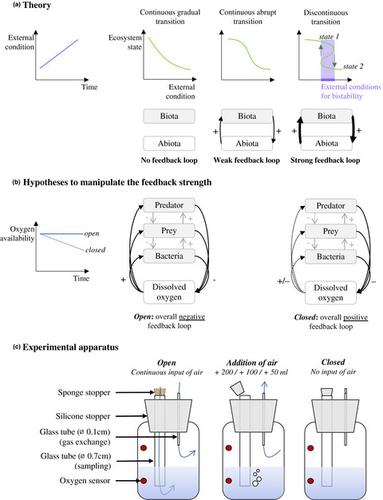当前位置:
X-MOL 学术
›
Ecol. Evol.
›
论文详情
Our official English website, www.x-mol.net, welcomes your
feedback! (Note: you will need to create a separate account there.)
Manipulating the strength of organism-environment feedback increases nonlinearity and apparent hysteresis of ecosystem response to environmental change.
Ecology and Evolution ( IF 2.3 ) Pub Date : 2020-05-11 , DOI: 10.1002/ece3.6294 Aurélie Garnier 1, 2 , Florence D Hulot 3 , Owen L Petchey 1, 4
Ecology and Evolution ( IF 2.3 ) Pub Date : 2020-05-11 , DOI: 10.1002/ece3.6294 Aurélie Garnier 1, 2 , Florence D Hulot 3 , Owen L Petchey 1, 4
Affiliation

|
Theory predicts that organism–environment feedbacks play a central role in how ecological communities respond to environmental change. Strong feedback causes greater nonlinearity between environmental change and ecosystem state, increases the likelihood of hysteresis in response to environmental change, and augments the possibility of alternative stable regimes. To illustrate these predictions and their dependence on a temporal scale, we simulated a minimal ecosystem model. To test the predictions, we manipulated the feedback strength between the metabolism and the dissolved oxygen concentration in an aquatic heterotrophic tri‐trophic community in microecosystems. The manipulation consisted of five levels, ranging from low to high feedback strength by altering the oxygen diffusivity: free gas exchange between the microcosm atmosphere and the external air (metabolism not strongly affecting environmental oxygen), with the regular addition of 200, 100, or 50 ml of air and no gas exchange. To test for nonlinearity and hysteresis in response to environmental change, all microecosystems experienced a gradual temperature increase from 15 to 25°C and then back to 15°C. We regularly measured the dissolved oxygen concentration, total biomass, and species abundance. Nonlinearity and hysteresis were higher in treatments with stronger organism–environment feedbacks. There was no evidence that stronger feedback increased the number of observed ecosystem states. These empirical results are in broad agreement with the theory that stronger feedback increases nonlinearity and hysteresis. They therefore represent one of the first direct empirical tests of the importance of feedback strength. However, we discuss several limitations of the study, which weaken confidence in this interpretation. Research demonstrating the causal effects of feedback strength on ecosystem responses to environmental change should be placed at the core of efforts to plan for sustainable ecosystems.
中文翻译:

操纵生物体-环境反馈的强度会增加生态系统对环境变化响应的非线性和明显的滞后性。
理论预测,生物体-环境反馈在生态群落如何应对环境变化中发挥着核心作用。强反馈会导致环境变化和生态系统状态之间更大的非线性,增加响应环境变化的滞后的可能性,并增加替代稳定制度的可能性。为了说明这些预测及其对时间尺度的依赖性,我们模拟了一个最小的生态系统模型。为了测试预测,我们操纵了微生态系统中水生异养三营养群落的新陈代谢和溶解氧浓度之间的反馈强度。该操纵由五个级别组成,通过改变氧气扩散率从低到高反馈强度:微观大气和外部空气之间的自由气体交换(代谢不会强烈影响环境氧气),定期添加 200、100 或50毫升空气,无气体交换。为了测试响应环境变化的非线性和滞后现象,所有微生态系统的温度都经历了从 15°C 逐渐升高到 25°C,然后又回到 15°C。我们定期测量溶解氧浓度、总生物量和物种丰度。在有机体-环境反馈较强的治疗中,非线性和滞后性较高。没有证据表明更强的反馈会增加观察到的生态系统状态的数量。这些经验结果与更强的反馈会增加非线性和迟滞的理论基本一致。因此,它们代表了反馈强度重要性的最早的直接实证检验之一。 然而,我们讨论了该研究的一些局限性,这削弱了人们对该解释的信心。证明反馈强度对生态系统对环境变化的响应的因果影响的研究应置于可持续生态系统规划工作的核心。
更新日期:2020-06-26
中文翻译:

操纵生物体-环境反馈的强度会增加生态系统对环境变化响应的非线性和明显的滞后性。
理论预测,生物体-环境反馈在生态群落如何应对环境变化中发挥着核心作用。强反馈会导致环境变化和生态系统状态之间更大的非线性,增加响应环境变化的滞后的可能性,并增加替代稳定制度的可能性。为了说明这些预测及其对时间尺度的依赖性,我们模拟了一个最小的生态系统模型。为了测试预测,我们操纵了微生态系统中水生异养三营养群落的新陈代谢和溶解氧浓度之间的反馈强度。该操纵由五个级别组成,通过改变氧气扩散率从低到高反馈强度:微观大气和外部空气之间的自由气体交换(代谢不会强烈影响环境氧气),定期添加 200、100 或50毫升空气,无气体交换。为了测试响应环境变化的非线性和滞后现象,所有微生态系统的温度都经历了从 15°C 逐渐升高到 25°C,然后又回到 15°C。我们定期测量溶解氧浓度、总生物量和物种丰度。在有机体-环境反馈较强的治疗中,非线性和滞后性较高。没有证据表明更强的反馈会增加观察到的生态系统状态的数量。这些经验结果与更强的反馈会增加非线性和迟滞的理论基本一致。因此,它们代表了反馈强度重要性的最早的直接实证检验之一。 然而,我们讨论了该研究的一些局限性,这削弱了人们对该解释的信心。证明反馈强度对生态系统对环境变化的响应的因果影响的研究应置于可持续生态系统规划工作的核心。











































 京公网安备 11010802027423号
京公网安备 11010802027423号